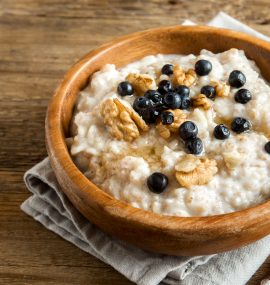Eat more whole grains
Oats and barley may be especially beneficial
Increased consumption of whole grains predicts reduced risk of type 2 diabetes, cardiovascular diseases, obesity, and certain cancers. The presence of dietary fiber, antioxidants, and phytochemicals in whole grains may account for their health-promoting properties. Researchers at Harvard studied the health benefits of selected whole-grain foods, as well as whole grain intake using data from three large prospective cohorts. They included the Nurses’ Health Study (69,139 women), the Nurses’ Health Study II (89,120 women), and the Health Professionals Follow-up Study (36,525 men). Food consumption data were collected using semi-quantitative food frequency questionnaires at multiple time periods in all three studies. Whole grain intake was grouped into five categories ranging from a median of 0.1 to 1.9 servings per day.
Over an average follow-up of 24 years, higher whole grain intake consistently predicted significantly lower risk of developing type 2 diabetes. After pooling the data from the three studies and compared to participants in the lowest quintile of whole grain intake, those in the highest quintile had 29 percent lower risk of type 2 diabetes. Likewise, increased intake of whole grain breakfast cereal, dark bread, oatmeal, brown rice, added bran, and wheat germ individually predicted significantly lower risks of type 2 diabetes ranging from 12 to 21 percent. The observed spread in risks among the different types of whole grain foods presumably reflects varying amounts and types of fiber, antioxidants, and phytochemicals in these foods. Eating two servings of whole grains each day may reduce your risk of type 2 diabetes.
Dietary habits appear to greatly affect the world-wide surge in the incidence of type 2 diabetes. Longitudinal studies have identified fruits, vegetables, nuts, fish, non-tropical oils, beans, yogurt, and whole grains as protective against type 2 diabetes. On the other hand, higher consumption of red meat, processed meat, eggs, and sugar-sweetened beverages predict increased risk of type 2 diabetes. A group of Italian researchers evaluated the evidence that whole grain intake predicts reduced risk of type 2 diabetes. Longitudinal studies suggest that increased intake of whole grains predicts lower risk of developing type 2 diabetes. The evidence from interventions and randomized clinical trials is less convincing. That notwithstanding, oat and barley, with their mix of insoluble and soluble fibers, especially seemed to benefit glucose metabolism. The available evidence suggests that 2-3 daily servings (60-90 grams or 2-3 ounces per day) of whole grains can reduce risk of type 2 diabetes without undesirable side-effects.
Accumulating evidence suggests that whole grain intake predicts lower risk of type 2 diabetes. But what’s the relationship between specific amounts of whole-grain intake and type 2 diabetes risk? Researchers in France and Finland conducted a systematic review and meta-analysis of eight studies to answer this question. They found that each 10 gram increase in daily whole-grain intake predicted a 0.2 percent decrease in type 2 diabetes development. The average whole-grain consumption in the US was assumed to be 10 grams per day. Increasing that amount to 45 grams per day (about three servings) would lower absolute type 2 diabetes risk by 0.6 percent. Given that the absolute type 2 diabetes risk of the US population is 4.9 percent, a 0.6 percent drop translates to a 20 percent lower risk of type 2 diabetes compared to Americans who consume only 7.5 grams of whole grains per day.
Researchers in Iran updated previous systematic reviews and meta-analyses that linked whole grain intake to risk of developing type 2 diabetes. Pooled data from 11 longitudinal studies that included 463,292 participants showed that compared to the lowest category of whole grain intake, participants in the highest category had a significant 21 percent lower risk of developing type 2 diabetes during follow-up. Each 50 gram (1.8 ounce) increase in whole grain intake predicted a 23 percent reduced risk of type 2 diabetes. Finally, the beneficial effect of additional whole grain intake plateaued at 60 grams per day. Increasing your whole grain intake, say with a bowl of thick-rolled oats in the morning, can reduce your risk of type 2 diabetes.
Increasing whole grain consumption appears to substantially reduce the risk of cardiovascular disease and type 2 diabetes. But would the economic benefits of increased whole grain intake amount to much? A team of researchers tackled with question with data from Australia using a modelling approach based on three increasing levels of whole grain intake. The levels were 1) a 10 percent increase (from the current level of 24 and 21 grams per day for men and women), 2) increase to the adequate level (30 and 25 grams per day for men and women), and 3) increase to the suggested dietary target (38 and 28 grams per day for men and women). The total annual healthcare and work productivity cost savings assuming that 100 percent of Australians met the suggested dietary target was $1.6 billion Australian dollars. This estimate is probably low because it did not include Australians with diabetes (for which greater whole grain intake would be healthful) nor did it include improved health of other chronic diseases (such as cardiovascular disease). While the assumption of 100 percent of Australians reaching the whole grain dietary target isn’t realistic, it gives a sense of the major potential cost savings of increased whole grain consumption.








